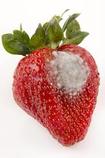There is a new thickener on the market you may not of heard of, Guar Gum. It definitely has some advantages over flour and cornstarch in certain applications. Guar gum is a stabilizer and thickener derived from the guar or clusterbean plant, which is native to India. It's often used as a gluten substitute in gluten-free baked goods, to give the product some structure. Guar Gum is used in many commercial products, but has not been discovered by many home cooks.
Advantages
Guar gum has almost 8 times the thickening power of corn starch and corn starch has twice the thickening power of flour. If you use 2 T. flour per cup of liquid, that would translate into about 3/8 teaspoon Guar Gum.
Guar Gum doesn't break down like cornstarch when heated. Technically, it requires no heat to thicken, but it takes a few minutes to hydrate, so heat is generally recommended.
Guar Gum does tend to clump when added to a liquid. Since the amounts of Guar Gum are so small, sprinkle it over the liquid and whisk vigorously. That works pretty well for me. If the lumps aren't too big, letting the sauce sit for a while should also help.
Applications
Salad Dressings
Pies
Adding the Right Amount for Thickening
- Use guar gum in place of flour or cornstarch in recipes to act as a thickening agent. When using guar gum in place of flour, use a sixteenth of what is called for in the recipe.
- Guar gum Substituted for Flour
For example, if your recipe calls for 2 tablespoons of flour, use 3/8 teaspoon of guar gum. If the recipe calls for 1/4 cup of flour, use 3/4 teaspoon of guar gum. Measure exactly, as even small changes in the amount of guar gum can result in a changed consistency. - Guar gum Substituted for Cornstarch
If you are replacing cornstarch in a recipe for thickening, use an eighth of what is called for. If the recipe calls for 2 tablespoons of cornstarch, use 3/4 teaspoon of guar gum. If the recipe calls for 1/4 cup, use a 1 1/2 teaspoons of guar gum.
- Since guar gum does not require heat for thickening, it is useful for thickening room temperature or cold dressings and sauces. Guar gum is relatively tasteless, especially since so little is used compared to the bulk of the recipe. Add the guar gum by 1/8- to 1/4-teaspoon increments and stir or shake well. Adding too much will give the food a gummy texture.
- Guar has a tendency to clump. To combat that, sprinkle the guar gum into the food evenly. Some people like to use clean spice shakers. Add the amount you want into the shaker and sprinkle it in, continuously stirring.
Read more : http://www.ehow.com/way_5296345_tips-use-guar-gum.html

 RSS Feed
RSS Feed
